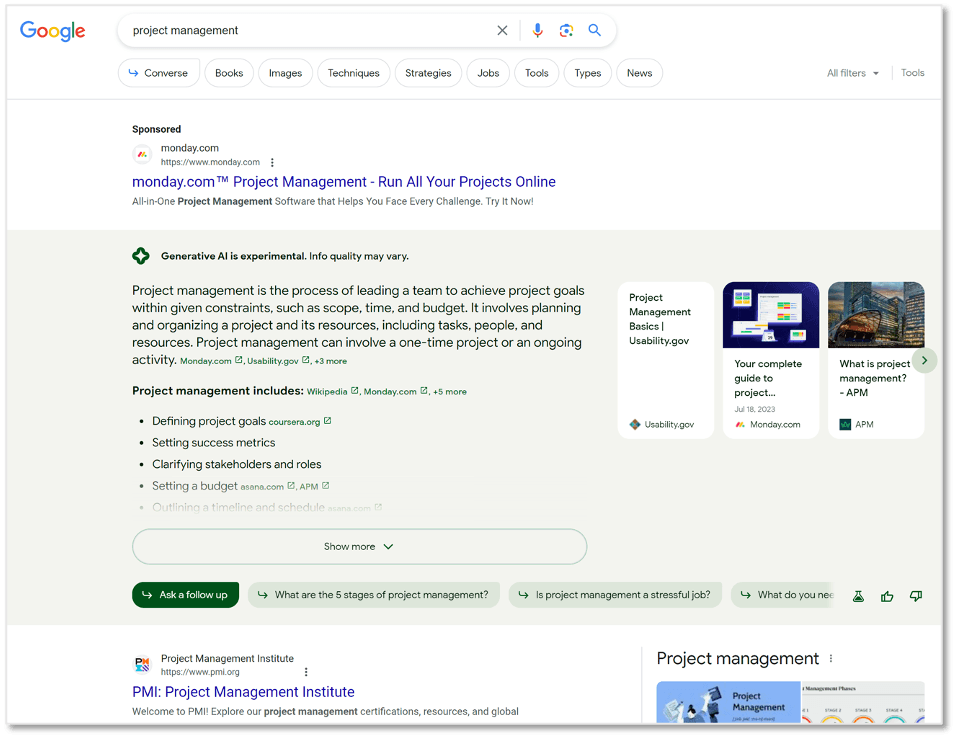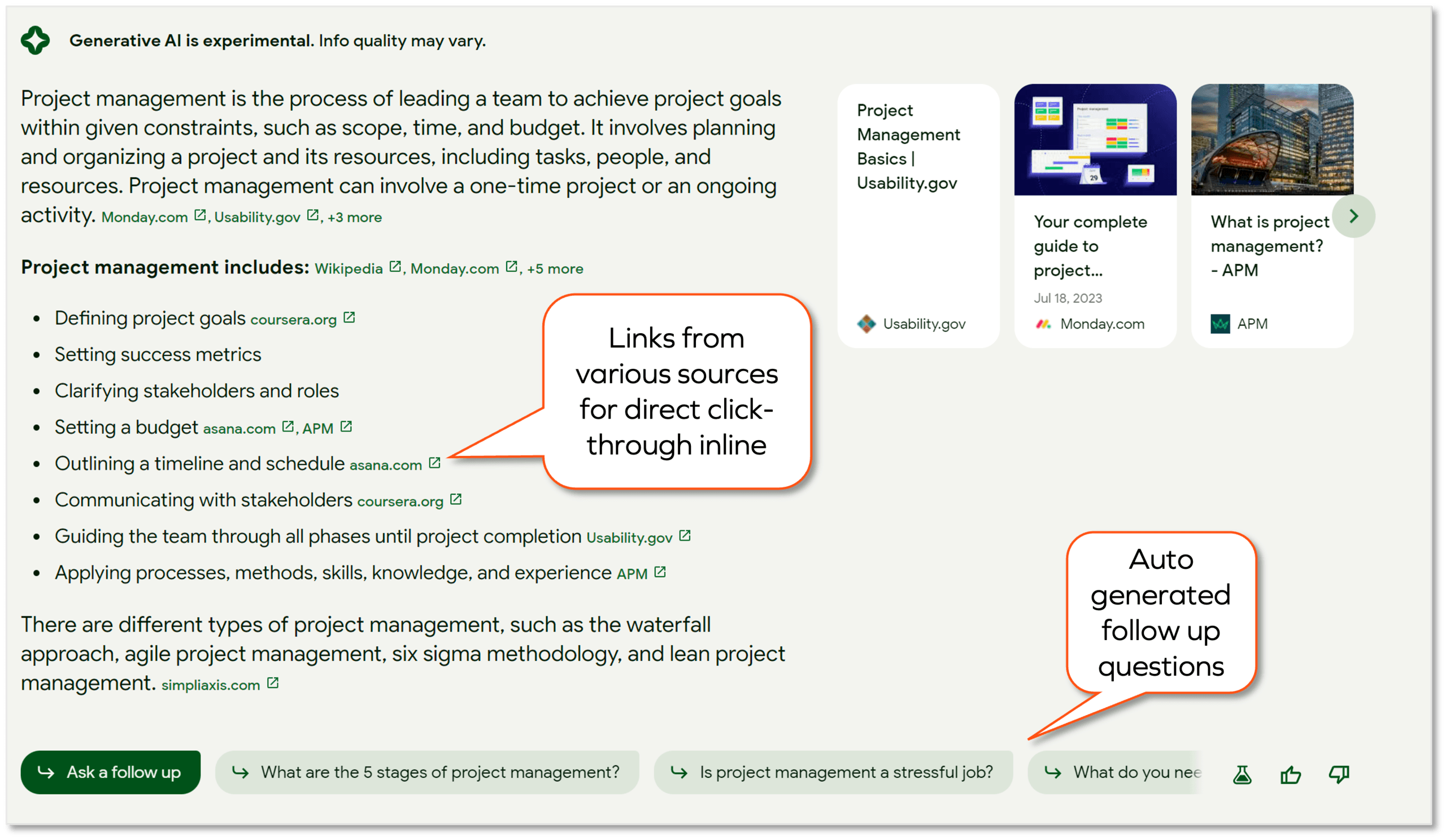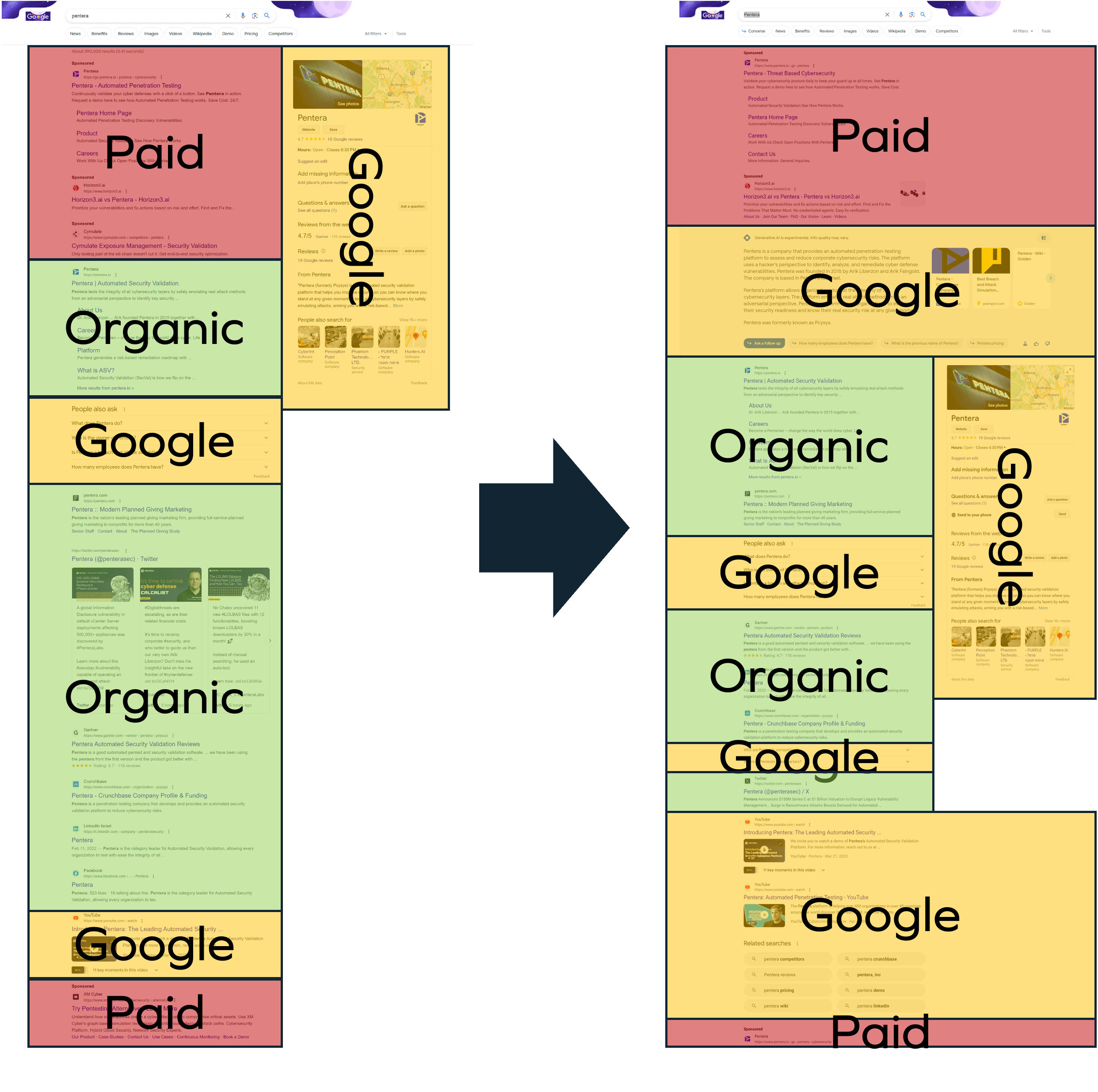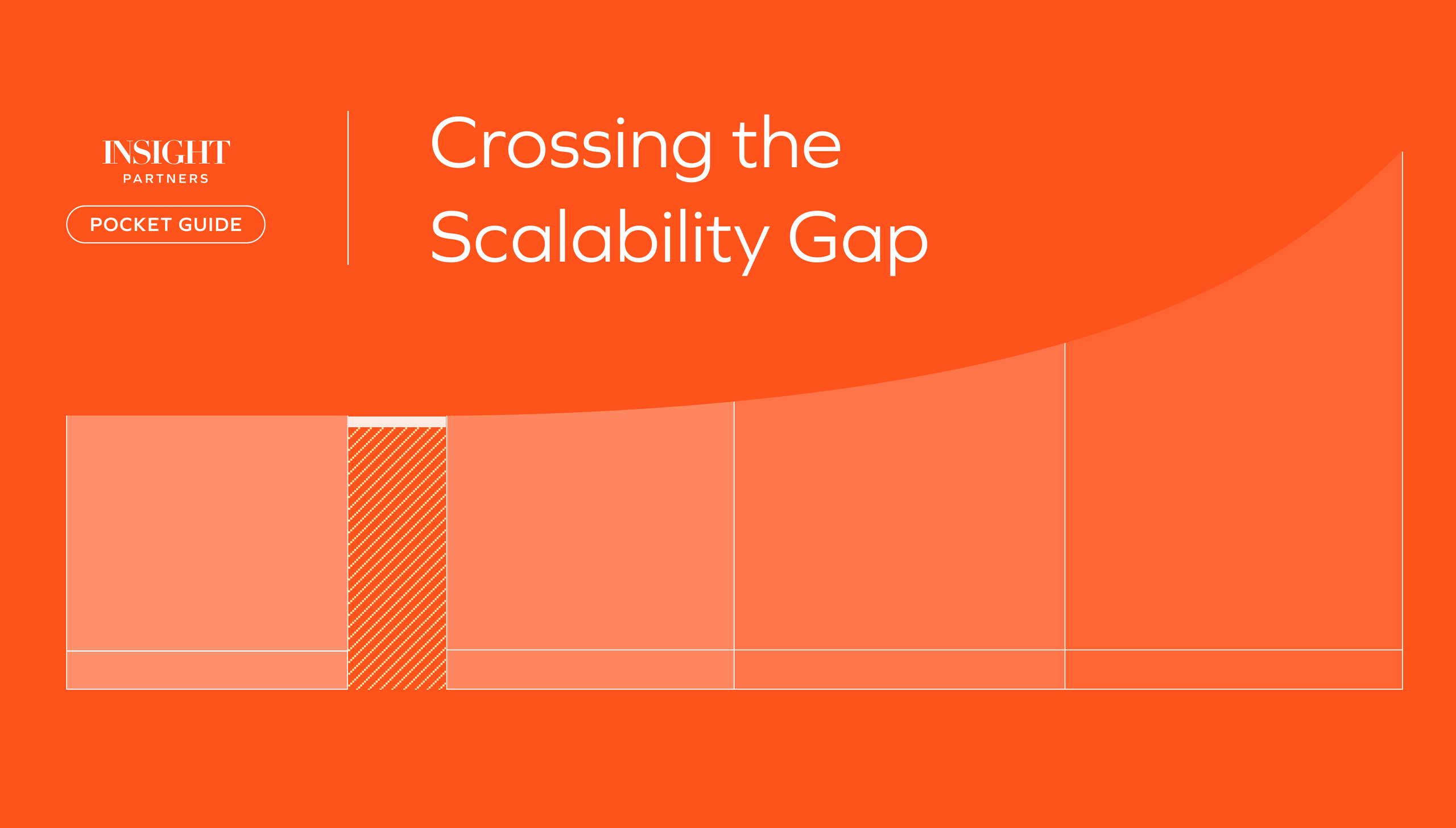SEO and content are two of the most important marketing channels used by Insight’s portfolio and forward-looking founders are starting to ask us questions about the impact of generative AI on search results. Our team has been researching the topic, and we believe the impacts will be significant.
GenAI will have a transformative effect on users’ search experience, and there will be myriad second-order impacts of that change in the scaleup ecosystem. Web traffic to companies could fall significantly, and GTM motions will be shaken up. New Google Labs experiments indicate the direction Google is moving, and we think it’s a bellwether for how search overall is evolving towards more zero-click searches.
What is a zero-click search?
A zero-click search means that users get answers on the search engine results page without clicking on links — by reading snippets, browsing headlines, or clicking on maps and local listings. 2022 data from SEM Rush shows that about half of Google searches were zero click, and that this has been trending up over time. Now genAI — or the threat of genAI-forward competitors — has given Google a catalytic push forward in its shift towards more zero-click searches.
Google is still the dominant search engine, and they’re testing using generative AI to answer search queries. If you haven’t seen it yet, you can request access to it in Google Search Labs, and you should start familiarizing yourself because it will change the future of search.
The Google results page of the future

Google is calling this the Search Generative Experience (SGE). It combines reliable data from multiple organic search results and uses Google’s LLM to turn it into a prose answer to a user’s search – all without having to click on any links in the results page. This is the logical extension of the Featured Snippets feature, and in fact, SGE relies heavily on the Featured Snippets algorithm to write their text.

SGE output provides a robust answer by aggregating multiple sources and provides a conversational interface for deeper questions. Links are available but are not the primary focus.
Overall, if you look at the Google results page of the future, there is far more screen real estate dedicated to Google search features and less available for organic and paid search results. As Google continues to experiment, the balance will shift — Google will only reduce its ad revenue from search if competitors force it, but it is likely that organic search will be fighting for space in a world where there is much less available than in the past.

The current Google results page (left) gives a majority of screen real estate to organic links. Google’s SGE-powered results page (right) gives far less space for organic search results.
Insight’s independent research has found that only 57% of links cited by SGE are from the first page of organic results.
Finally, another big change is that the links cited by SGE are not the same ones at the top of traditional search results. Insight’s independent research has found that only 57% of links cited by SGE are from the first page of organic results. The first SGE link is the same as the first organic link only 12% of the time, and in 45% of searches, it isn’t even from the top 10. If users start switching their reading habits and clicking behavior to the SGE box, this could be a huge shift in traffic and eyeballs.
What does this mean for scaleup companies?
SEO will be changing. Every time Google has an algorithm update, there are winners and losers in the market. Panda, in 2011, famously demolished eHow, cutting their traffic by almost 50% and funneling lots of it to their rival Wikihow. This shift has a chance to be just as big and disruptive. GenAI will introduce new strategies for technical on-page and off-page SEO. SEO is not dead, but it will be dramatically different.
SEO is not dead, but it will be dramatically different.
Content strategy changes
Content teams will need to adapt and start figuring out how to create content that ranks highly in SGE and gets clicks. This might mean a focus on new types of media (like video or podcasts) or more syndication of content into third parties. It could also mean a focus on more independent research that provides unique perspectives for a genAI to cite. Content will still be important, but the answer is not to use genAI to mindlessly increase production — precision and an evolving strategy will be required.
Expect search traffic declines of up to 25%
Web Traffic will likely decline. More importantly than just the algorithm update, the evolution towards a zero click world means less traffic coming to your webpage. Insight’s analysis across our portfolio and conversations with other leading experts put the expected traffic drop in the range of 15-25%. Some of that loss will be low-quality traffic that was never going to turn into real revenue, but some will not.
Some experts have opined that Featured Snippets didn’t hurt SEO traffic significantly, so we shouldn’t be concerned about the impact of SGE. This is faulty logic for two core reasons. Featured Snippets have never been very prevalent, appearing in only 18% of searches. By comparison, Google is testing SGE on all non-sensitive and non-political searches. Featured Snippets have also always had excellent click-through rates. SGE, with its amalgamation of multiple sources and better context to users, will reduce those click-through rates. Google will also allow users to ask follow-up questions directly in a conversational format, further reducing click-through rates.
Traffic fuels so many aspects of your GTM engine. Lead quantity could go down even if quality goes up. Retargeting campaigns may be able to target only a fraction of their previous audience. Lead scoring accuracy may be reduced if more research is done off-site. Brand scorecards and awareness campaign measurement could be less accurate.
Paid search will be in flux
Google’s SGE results pages average fewer ads above the fold than Google’s traditional results pages did (1.2 vs. 2.4 ads). Google will only reduce its ad revenue from search if competitors force it — but Bing, Claude, and ChatGPT offering new ways to search for information offer exactly that competition.
Even if the SGE that eventually goes live does have more ad slots, it likely won’t be enough. There will still be some pressure on ad inventory, increasing the competition in auctions and leaving companies that don’t have other proven channels for paid demand generation in a difficult spot.
What should leaders do?
SGE is coming, and the worst thing you could do is nothing. You need to lay the groundwork now: sources inside Google tell us that SGE will be rolled out in limited circumstances to a small sample (<1%) of users in Q4. Google will use this to collect additional data and tweak the product, but competitive pressure from Bing and ChatGPT will likely force a widespread rollout in 2024.
CEOs and founders should ensure that their org has a plan and knows what the impact might be on achieving growth goals in 2024. Marketing leaders need to direct their teams to develop the approaches and testing to begin to understand the real impact, and how to respond to these major changes. So, what should you do today to prepare for this zero-click world? There are no definitive answers right now, so the best advice we have is to be engaged, proactive, and real.
Be Engaged
- If you haven’t signed up to test SGE, you can access it in Google Search Labs and see it in action.
- Run your branded and non-branded search terms through SGE and see where you rank in SGE results.
- Experiment with Bing’s chat search functionality — it also gives clues to the direction generative search experiences could go.
- Get other members of your team to start testing out the tool themselves.
Be Proactive
- Establish a “war room” — now is not the time to let your SEO and SEM strategy run on autopilot.
- Even if you’re using an agency, get involved to ensure that your search strategy is up to date.
- Start experimenting with other paid channels, like LinkedIn, so you aren’t completely reliant on SEO and SEM when changes happen.
- If you don’t like how your brand is portrayed by SGE, start engaging and having advocates participate in public communities and third-party sites.
- Map out your most important keyword clusters that you want to defend and those that you want to attack.
Be Real
- Quantify the risk to your traffic. Insight has a customized scorecard that we can provide for our portfolio companies to quantify your expected risk. Otherwise, you’ll need to build your own.
- Quantify the risk to your lead volume and revenue. Look at the source of leads and revenue and determine how much is driven by SEO and SEM.
- Think through other aspects of your GTM motion that a reduction in traffic could impact and how you will react.
The zero-click world is approaching fast
In times of disruptive change, it is hard to know what is real and what is hype. We believe that in the very near future, far more users will never click on a link after a search. GenAI results from Google and Bing and the proliferation of new search mediums will mean far more queries are answered for users without ever leaving these platforms. Ultimately, you will see less traffic for your site and will need a totally new approach for organic and paid search.
Don’t be like the companies that got decimated by Google’s updates in the past. Seeing SGE in advance allows you to confront this brave new world with a coherent plan.








